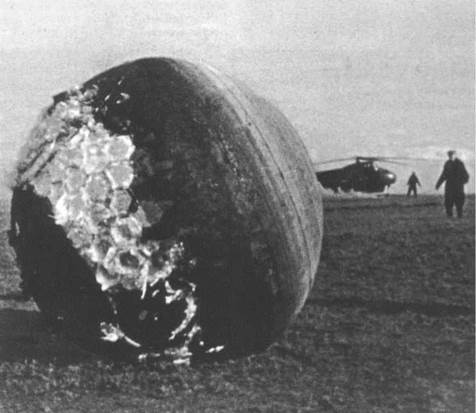REACTION
Twenty minutes after the R-7 blasted off, Nikolai Kamanin boarded an An-12 aircraft, bound for the industrial city of Kuibishev, today’s Samara. With him were Gherman Titov, Mark Gallai and a substantial delegation from Tyuratam. Whilst airborne, they learned of Gagarin’s landing in Saratov and toasted his success with cognac. The cosmonaut, meanwhile, had already spoken with Nikita Khrushchev by telephone from Engels, before heading on to Kuibishev. On the outskirts of the city, in a special dacha on the banks of the Volga, Gagarin was given a medical examination and a day’s rest before his journey to Moscow. The mission was over. Shortly, his new life as an international celebrity would begin.
But not yet. On 13 April, whilst still secluded in the Kuibishev dacha, he underwent his official, two-and-a-half-hour interview by the Vostok State Commission; the only opportunity for ‘the truth’ about the mission to be revealed, behind closed doors, to Korolev, Kamanin and other high-ranking officials. Although he undoubtedly described the problem with the instrument section, it remains unclear as to why this was not properly resolved in time for the next flight, Vostok 2, other than the possibility that changes were implemented, but failed to work. Meanwhile, efforts to secure the World Aviation Altitude Record had already led sports official Ivan Borisenko to hurriedly get the First Cosmonaut’s signature on FAI documents within hours of landing. In his fictitious account of the proceedings, published in 1978, Borisenko would recall “dashing up to the descent module, next to which stood a smiling Gagarin”. The reality that capsule and cosmonaut landed a couple of kilometres apart was kept closely guarded.
After his day on the Volga, during which time he also played billiards with Titov and described his experiences, Gagarin flew to Moscow on the morning of 14 April aboard an Ilyushin-18. He had already rehearsed the half-hour speech that he would deliver to Khrushchev – in which Nikolai Kamanin played the role of the Soviet leader – but could hardly have anticipated the sheer outpouring of adoration for him. On the outskirts of the capital, a squadron of seven MiG fighters intercepted his aircraft and escorted him down Lenin Prospekt, Red Square and along Gorky Street to Vnukovo Airport, where the Il-18 touched down just 100 m from Khrushchev’s flower-bedecked reception stand. The premier congratulated Gagarin, announcing that “you have made yourself immortal because you are the first man to penetrate space’’. Following the party line and successfully currying immense favour with Khrushchev, the First Cosmonaut responded by challenging the “other countries’’ to try to catch up with superior Soviet technology.
However, partly due to sour grapes, but mainly because of the intense mistrust that the Russians had themselves created through their ridiculous secrecy, some observers in those ‘other countries’ were already doubting that the mission had happened at all or – at the very least – that it had not occurred precisely as reported. The Soviet campaign of misinformation became evident when their sports officials filled in the FAI paperwork to register Gagarin’s flight on 30 May 1961. The name and co-ordinates of the launch site, they wrote, were ‘Baikonur’ at ‘47°22’00"N, 65°29’00"E’, whereas in reality the site was close to Tyuratam at 45°55’12.72"N, 63°20’32.32"E, a considerable distance to the south-west. Indeed, speculation abounded as late as July 1961 over conflicting reports, obscure photographs and a lack of reliable eyewitnesses. Other suspicions lingered over whether Gagarin landed in his capsule or by parachute. On 17 April, just five days after the mission, a correspondent for the London Times wrote that ‘‘no details have been given about the method of landing’’ and revealed that, when questioned at a press conference, Gagarin had ‘‘skated over the question’’.
Nonetheless, within hours of the flight, NASA Administrator Jim Webb appeared on American television to congratulate the Soviets and express his disappointment, but also to offer reassurance that Project Mercury – the United States’ own man-in-space effort – would not be stampeded into a premature speeding-up of its schedule. His remarks did little to dampen the fury of the House Space Committee, which verbally roasted both Webb and his deputy, Hugh Dryden, on 13 April. It made no difference; the Soviets had won the first lap of the space race and John Kennedy, still only months into his presidency, had to respond with something spectacular. Faced with persistent questions from Congress as to why the United States should remain in second place to Russia in space, together with a perceived ‘gap’ in missile-building technology, Kennedy knew that Project Mercury’s first manned flight would not even match, let alone surpass, Vostok’s achievement. Indeed, it was unlikely that a single-orbit piloted mission could be attempted before the end of 1961, so temperamental was the new Atlas launch
|
Rumour has abounded for years that this is Gagarin’s sharik after touchdown. It was said to have been so badly damaged that it required extensive repairs before it could be placed on display. |
vehicle needed to achieve such a feat. By that time, the Soviets could well have pushed their lead even further.
A goal on a longer-term basis, with an above-average chance of success, was crucial for America’s young president. On 14 April, Kennedy called an informal brainstorming session with several aides to discuss suitable space goals. Landing a man on the Moon emerged as the best option to draw the Soviets into a race which the United States could conceivably win. Not only would it convey a message to the world of American technological prowess, but it would clearly beat Russia. A few days later, however, circumstances on a Caribbean island just south-east of Florida made Kennedy’s need for something – anything – to bolster his administration even more urgent.
The Bay of Pigs 27











